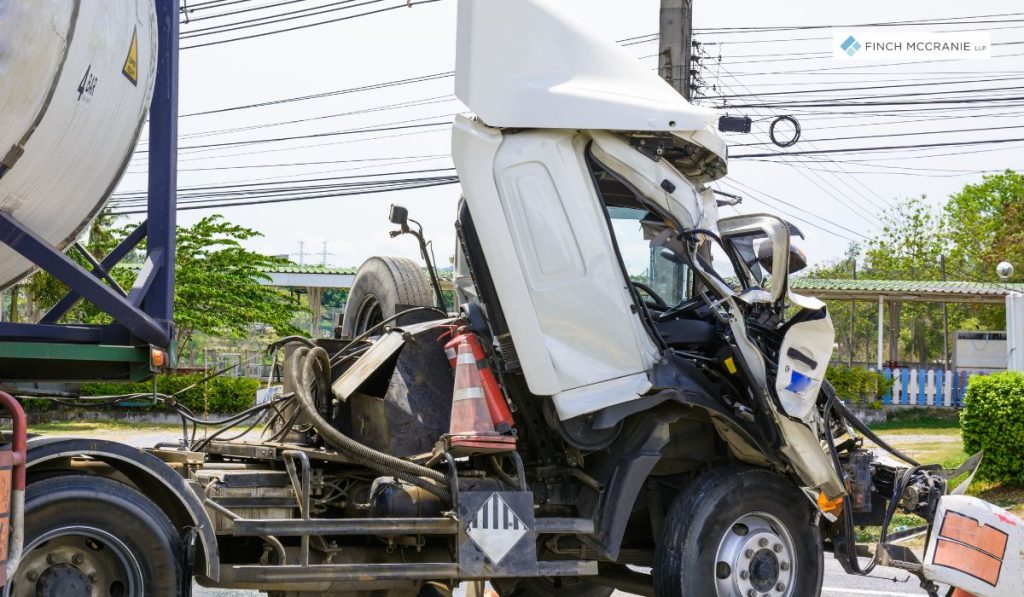The sight of massive 18-wheelers barreling down highways is a common occurrence in the modern world, facilitating the transportation of goods across vast distances.
While the trucking industry plays a crucial role in our economy, it comes with a darker side that often goes unnoticed—the disturbing frequency of 18-wheeler accidents.
In this article, we delve into ten unsettling facts surrounding these accidents, shedding light on the various aspects that contribute to their occurrence and the consequences that follow.
The roads we traverse are shared by an intricate dance of vehicles, each with its own purpose and challenges.
At the forefront of this transportation ballet are the colossal 18-wheelers, transporting goods that keep our economies moving.
However, this seemingly efficient system hides a grim reality—truck accidents, particularly those involving 18-wheelers, are alarmingly common.
Here are 10 Disturbing Facts About 18-Wheeler Trucking Accidents
Alarming Statistics
Recent data reveals a disturbing truth about 18-wheeler accidents.
These incidents significantly contribute to overall vehicular incidents, with the sheer size and weight of these trucks amplifying their impact.

In the United States, National Highway Traffic Safety Administration (NHTSA) reports highlight the high fatality rates associated with these accidents compared to smaller vehicles.
The economic toll, encompassing vehicle damage, infrastructure costs, and medical expenses, underscores the urgency in addressing the root causes of these alarming statistics for enhanced public safety and effective policy measures.
Fatigue-Related Incidents
As we navigate the labyrinth of 18-wheeler accidents, one prominent factor emerges—driver fatigue.
The demanding schedules imposed on truckers, coupled with long hours on the road, create an environment ripe for fatigue-related incidents.
Fatigue impairs cognitive functions, slowing reaction times and compromising the ability to make critical decisions, thereby increasing the risk of accidents.
Additionally, the monotony of extended driving hours exacerbates the impact of fatigue, leading to a higher likelihood of lapses in attention and concentration.
This heightened risk further underscores the urgent need for interventions and policies addressing driver fatigue in the trucking industry.
Mechanical Failures
Beyond the human element, mechanical failures in 18-wheelers significantly contribute to accidents.
Brake malfunctions and engine issues, often stemming from inadequate maintenance, pose substantial risks on the road.
Regular checks and timely repairs are essential to prevent these accidents, emphasizing the importance of a well-maintained fleet.
The intricate machinery within these massive trucks demands meticulous attention to ensure all components operate seamlessly.
Neglecting maintenance not only jeopardizes the safety of the truckers but also endangers the lives of other road users, making it imperative to prioritize proactive mechanical care.
Overloaded Trucks
The temptation to maximize profits by overloading trucks poses a considerable risk on the roads.
Overloaded 18-wheelers experience compromised braking systems and reduced overall stability.
This significantly elevates the chances of accidents, making it imperative for both drivers and companies to adhere to weight limits and prioritize safety over financial gains.
Beyond the immediate threat to road safety, overloading also accelerates wear and tear on the truck’s components, exacerbating the risk of mechanical failures.
The long-term impact on both safety and the longevity of the fleet underscores the need for strict adherence to weight regulations.
Inadequate Training
A critical factor often overlooked is the level of training provided to truck drivers.
Inadequate training contributes to lapses in understanding crucial aspects of road safety, such as maneuvering in challenging conditions and responding to emergencies.
Drivers need comprehensive training to navigate the complexities of operating massive 18-wheelers, especially in adverse weather or unexpected situations.
The gap in training not only jeopardizes the safety of the driver but also poses significant risks to other road users.
Addressing this deficiency is pivotal to enhancing the overall safety of 18-wheeler operations and reducing the likelihood of accidents stemming from insufficient driver preparation.
High-Speed Collisions
The consequences of high-speed 18-wheeler collisions are devastating.
The sheer mass and momentum of these trucks magnify the impact, often leading to catastrophic results.
Unlike smaller vehicles, the immense size of 18-wheelers poses an increased risk of fatalities and extensive damage in high-speed accidents.
Understanding the dynamics of high-speed collisions is crucial for both drivers and policymakers.
Implementing measures to mitigate the severity of such incidents becomes imperative, ranging from speed limit regulations for trucks to advanced safety technologies that can assist drivers in maintaining control at higher speeds.
Weather-Related Challenges
Navigating adverse weather conditions adds an extra layer of complexity to 18-wheeler operations.
Rain, snow, and fog create hazardous driving conditions, increasing the likelihood of accidents.
Drivers must be equipped with the skills and knowledge to navigate these challenges safely, adjusting their driving techniques to match the specific weather conditions they encounter.
Infrastructure improvements also play a crucial role in minimizing weather-related accidents.
Well-maintained roads, effective drainage systems, and timely snow removal contribute to safer driving conditions for 18-wheelers, reducing the risks associated with adverse weather.
Poorly Maintained Roads
The state of our roads directly impacts the occurrence of 18-wheeler accidents.
Poorly maintained roads contribute to uneven surfaces and increased wear on vehicles, making accidents more likely.
Potholes, cracks, and uneven road surfaces pose significant challenges for the stability and control of 18-wheelers, potentially leading to accidents.
A concerted effort in maintaining and upgrading infrastructure is crucial to creating safer conditions for both truckers and other road users.
Timely road repairs and improvements not only enhance safety but also contribute to the overall efficiency and sustainability of the transportation network.
Inadequate Regulatory Measures
Examining the regulatory landscape reveals gaps that leave room for improvement in preventing 18-wheeler accidents.
Inconsistent regulations across states and regions contribute to a lack of standardized safety measures, creating a fragmented approach to overseeing the trucking industry.
Strengthening and harmonizing regulations on a national level can create a more robust framework, ensuring a unified and comprehensive set of standards that prioritize safety and mitigate risks associated with the operation of 18-wheelers on diverse road networks.

Environmental Impact
Beyond the immediate consequences, 18-wheeler accidents have a lasting environmental impact.
Spillages of hazardous materials pose a threat to ecosystems, with the potential to contaminate soil, water, and air.
The long-term effects of such incidents contribute to environmental degradation, affecting biodiversity and ecosystem health.
Addressing these aspects is vital for a holistic approach to preventing accidents.
It involves not only enhancing safety protocols to minimize the likelihood of spills but also implementing swift and effective response measures to mitigate environmental damage in the aftermath of accidents involving 18-wheelers.
Conclusion
In conclusion, the prevalence of 18-wheeler trucking accidents reveals a multifaceted challenge that demands urgent attention and comprehensive solutions.
The alarming statistics underscore the significant impact of these accidents on public safety, with high fatality rates and substantial economic costs.
Driver fatigue emerges as a critical factor, emphasizing the need for interventions addressing work schedules and fatigue management.
Mechanical failures, often stemming from inadequate maintenance, highlight the importance of proactive care for the intricate machinery within these massive trucks.
In addressing these disturbing facts about 18-wheeler trucking accidents, a collaborative effort involving policymakers, industry stakeholders, and the public is crucial.
Prioritizing safety through enhanced regulations, improved training, and proactive maintenance can contribute to creating a safer road environment for everyone, mitigating the human, economic, and environmental toll associated with these incidents.
If you or someone you know has been affected by a trucking accident, seeking legal advice and assistance is essential.
Contact Finch McCranie LLP for guidance and support in navigating the complexities of trucking accident cases.
FAQs
What are the alarming statistics surrounding 18-wheeler accidents?
Recent data reveals that 18-wheeler accidents significantly contribute to overall vehicular incidents, with high fatality rates compared to smaller vehicles. The economic toll, including vehicle damage, infrastructure costs, and medical expenses, underscores the need for urgent attention to address the root causes.
How does driver fatigue contribute to 18-wheeler accidents?
The demanding schedules and long hours on the road create an environment ripe for fatigue-related incidents. Fatigue impairs cognitive functions, slowing reaction times and compromising critical decision-making abilities, increasing the risk of accidents.
What role do mechanical failures play in 18-wheeler accidents?
Mechanical failures, such as brake malfunctions and engine issues, significantly contribute to accidents. Inadequate maintenance poses substantial risks, emphasizing the importance of regular checks and timely repairs to ensure the safety of both truckers and other road users.
How does overloading trucks contribute to the risk of accidents?
Overloaded 18-wheelers experience compromised braking systems and reduced stability, significantly elevating the chances of accidents. Adhering to weight limits is crucial to ensure road safety and prevent both immediate threats and long-term wear on truck components.
How does inadequate training affect 18-wheeler accidents?
Inadequate training contributes to lapses in understanding crucial aspects of road safety, jeopardizing the safety of the driver and posing risks to other road users. Comprehensive training is essential for navigating the complexities of operating massive 18-wheelers, especially in adverse conditions.
Why are high-speed 18-wheeler collisions particularly devastating?
The sheer mass and momentum of 18-wheelers magnify the impact in high-speed collisions, often leading to catastrophic results with increased risk of fatalities and extensive damage. Implementing measures to mitigate the severity of such incidents is crucial for both drivers and policymakers.
How do adverse weather conditions contribute to 18-wheeler accidents?
Rain, snow, and fog create hazardous driving conditions, increasing the likelihood of accidents. Drivers must be equipped with the skills to navigate these challenges safely, and infrastructure improvements play a crucial role in minimizing weather-related accidents.
What impact do poorly maintained roads have on 18-wheeler accidents?
Poorly maintained roads contribute to uneven surfaces and increased wear on vehicles, making accidents more likely. Timely road repairs and improvements are crucial for creating safer conditions for both truckers and other road users.
 Trial Attorney Blog
Trial Attorney Blog

